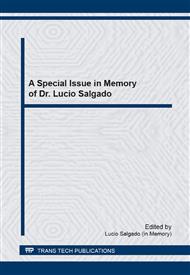p.337
p.343
p.350
p.356
p.362
p.368
p.374
p.380
p.386
Microstructural and Mechanical Characterization of the Niobium Cold Deformed-Swage
Abstract:
The refractory metals and their alloys show excellent mechanical behavior in high temperatures and high resistance to corrosion and to wear and good thermal conductivity. The metals that constitute this group are, traditionally, tantalum, molybdenum, tungsten and niobium. Niobium (Nb) is a metal with 2468°C melting point, density 8.57 g/cm3 and CCC crystalline structure, is characterized by its excellent ductility and reasonable mechanical resistance in high temperatures. Due to these properties, o Nb is applied in chemical, nuclear and electrical industry and in the superconductor wire production. One of the processes used in niobium plastic deformation is the swage that consists in one direct deformation process, which can be done at hot or cold temperature, used to modify the transversal section area of bars, tubes and wires. The microstructure evolution during a plastic deformation is very important in the relation of deformation mechanism, mechanical property and texture formation. The aim of this work is to evaluate the microstructural and mechanical behavior of metal cold rotary forging – swage using the techniques of Scanning Electronic Microscopic – SEM e microhardeness Vickers. Metallographic analysis of the microstructure of Nb after deformation of 96.4%, shows a distorted shape called "ripple". The Vickers microhardeness results indicate that there is a gradual increase in the microhardness of Nb up to 80% reduction in area taking place stabilization after this value. It may be noted that in both directions, the center of sample had higher hardness values
Info:
Periodical:
Pages:
362-367
Citation:
Online since:
September 2014
Keywords:
Price:
Сopyright:
© 2015 Trans Tech Publications Ltd. All Rights Reserved
Share:
Citation:


